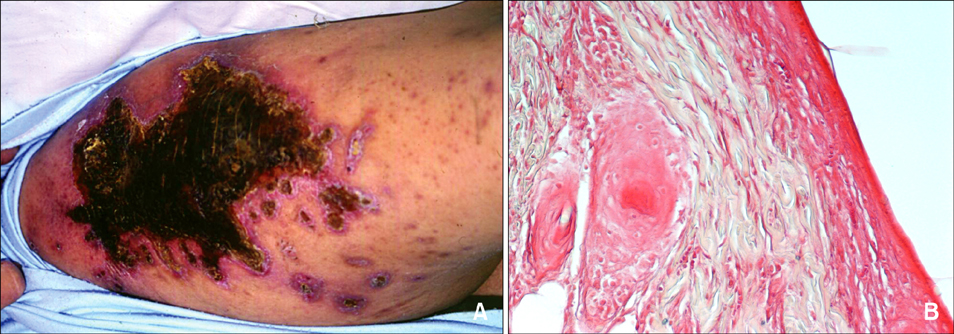Ann Dermatol.
2014 Feb;26(1):96-98. 10.5021/ad.2014.26.1.96.
Warfarin-Induced Skin Necrosis
- Affiliations
-
- 1Department of Surgery-Plastic Surgery, Democritus University of Thrace, Alexandoupolis, Greece. despoinakakagia@yahoo.com
- 2Department of Internal Medicine, Democritus University of Thrace, Alexandoupolis, Greece.
- 3Department of Orthopedics, Red Cross Hospital, Athens, Greece.
- KMID: 2265704
- DOI: http://doi.org/10.5021/ad.2014.26.1.96
Abstract
- Warfarin-induced skin necrosis is an infrequent complication occurring in individuals under warfarin treatment who have a thrombophilic history or after administration of large loading doses of warfarin particularly without simultaneous initial use of heparin. A 62-year-old lady developed skin necrosis 4 days after initiating warfarin therapy of 5 mg daily without initial co-administration of heparin. The patient had a normal clotting profile. Skin necrosis progressed to eschar formation after cessation of warfarin and heparinization stopped expanding. Warfarin was reintroduced at 2 mg daily, initially together with low molecular weight heparin. Autolytic debridement of the necrotic tissue was followed by healing of the cutaneous deficit by secondary intention. Prompt diagnosis and discontinuation of warfarin are crucial for the prognosis.
Keyword
MeSH Terms
Figure
Reference
-
1. Eby CS. Warfarin-induced skin necrosis. Hematol Oncol Clin North Am. 1993; 7:1291–1300.
Article2. Broekmans AW, Bertina RM, Loeliger EA, Hofmann V, Klingemann HG. Protein C and the development of skin necrosis during anticoagulant therapy. Thromb Haemost. 1983; 49:251.
Article3. Wattiaux MJ, Hervé R, Robert A, Cabane J, Housset B, Imbert JC. Coumarin-induced skin necrosis associated with acquired protein S deficiency and antiphospholipid antibody syndrome. Arthritis Rheum. 1994; 37:1096–1100.
Article4. Moreb J, Kitchens CS. Acquired functional protein S deficiency, cerebral venous thrombosis, and coumarin skin necrosis in association with antiphospholipid syndrome: report of two cases. Am J Med. 1989; 87:207–210.
Article5. Dahlbäck B. Protein S and C4b-binding protein: components involved in the regulation of the protein C anticoagulant system. Thromb Haemost. 1991; 66:49–61.
Article6. Nazarian RM, Van Cott EM, Zembowicz A, Duncan LM. Warfarin-induced skin necrosis. J Am Acad Dermatol. 2009; 61:325–332.
Article7. Warkentin TE. Venous limb gangrene during warfarin treatment of cancer-associated deep venous thrombosis. Ann Intern Med. 2001; 135:589–593.
Article
- Full Text Links
- Actions
-
Cited
- CITED
-
- Close
- Share
- Similar articles
-
- Warfarin Induced Skin Necrosis
- Warfarin-induced Skin Necrosis After Valve Surgery
- Warfarin-induced Leukocytoclastic Vasculitis
- Warfarin-induced Mesenteric Bleeding and Small Bowel Necrosis
- Warfarin skin necrosis mimicking calciphylaxis in a patient with secondary hyperparathyroidism undergoing peritoneal dialysis


